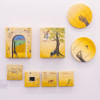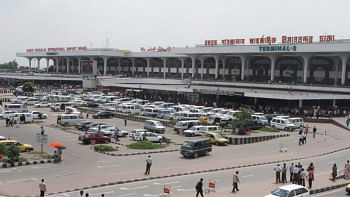‘Until the Rongrang Sings’: An aching story of our hilly regions

The hill tracts stand as one of the most alluring destinations for a large segment of Bangladesh's upper class. Yet, amidst the facade of joyful vacations, do they ever pause to ponder the tragedies concealed within? These hilly regions harbour tales unfamiliar to most, and the colossal business tycoons orchestrating the tourist attractions remain indifferent to the environmental havoc they wreak.


"Until the Rongrang Sings" serves as a wake-up call for Bangladeshis, urging us to safeguard our environment.
Jayatu Chakma, an emerging artist from Rangamati, unveils his second solo exhibition, "Until the Rongrang Sings", the first one being held in Kolkata. Renowned figures like Artist and Professor Dhali Al Mamooon and Queen Yan Yan, advisor of Chakma Circle and Indigenous Human Rights activist, graced the inauguration ceremony.


This exhibition, curated by Sharmillie Rahman at Kala Kendra, Dhaka, showcases four years' worth of Jayatu's artistic endeavours.

Rongrang, in indigenous dialect, or Raj Dhanesh in Bangla, alludes to the Hornbill bird, once abundant in the hill tracts of the Chattogram division. However, rampant deforestation and hill annihilation have brought this exquisite bird to the brink of extinction. The dwindling population of Rongrang mirrors the fate of numerous other animal species, leading to an ecological imbalance in the hill tracts. Furthermore, indigenous communities residing in these hills grapple with food shortages, exacerbated by soil and pebble removal, which has despoiled hilly rivers, streams, and fountains, precipitating a water crisis. For these communities, deeply intertwined with nature for sustenance, the repercussions are dire.




Jayatu's art vividly portrays the multifaceted damage inflicted upon the environment and culture. He highlights how the construction of the Kaptai dam in the 1960s submerged vast areas, displacing indigenous inhabitants. This displacement persists today as tourist spots continue to emerge, erasing indigenous homes. Notably, Jayatu sculpted a submerged Chakma king's palace enclosed within a column, symbolising the submergence of cultural heritage.

His use of excavators in sculptures underscores the environmental peril posed by hill construction projects. His paintings feature people adorned with Rongrang bird faces, symbolising the intertwined fate of these birds and indigenous communities.
The exhibition also features a sculpture of a sliced water pot, emblematic of ethnic cultures, particularly the Mros, who employ it for storing water and playing music during festivals. This sculpture underscores the erosion of not only habitats but also cultural elements within our nation. Jayatu portrays Jhum (shifting cultivation) farmers as superheroes striving to preserve hill culture.

"Until the Rongrang Sings" incorporates digital photomontages elucidating how we prioritise tourist comforts without considering their impact on ethnic groups. In essence, Jayatu Chakma's exhibition comprises simple yet thought-provoking drawings, paintings, needlework, digital prints, sculptures, and installations, testifying to our relentless demolition of not just diverse terrains but also the ecology and culture of our hill tracts.

Kala Kendra will host this open-for-all exhibition until May 14.

 For all latest news, follow The Daily Star's Google News channel.
For all latest news, follow The Daily Star's Google News channel. 






Comments